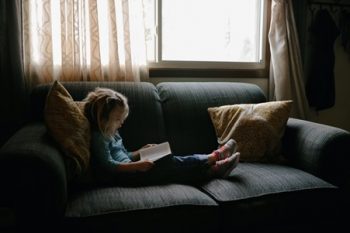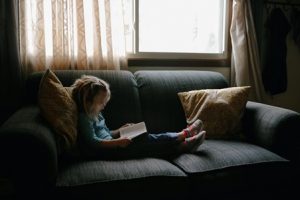
June 21, 2021, by Rupert Knight
Children reading in lockdown
In 2020, the National Literacy’s Trust’s (NLT) research revealed how UK children’s reading practices (age 8-18) changed during the first lockdown (from March 2020).
Prior to the lockdown, the Trust’s Annual Literacy Survey had sadly revealed a 15-year low in children’s enjoyment of reading. However, the 2020 survey showed that children read and enjoyed reading more during lockdown, leading Helen Victoria Smith to reflect on why this might have been, and the possible implications for teachers, parents and librarians now that most children have returned to school.
The will and the skill to read
NLT’s research showed that many children were choosing to read in lockdown because it provided a refuge when they were struggling with not being able to see family and friends, and were feeling unsure about the future. Rather than reading ‘for school’, where children are often encouraged to read through the use of reading diaries that document reading frequency, or book-bands they must progress through, children were reading ‘for themselves’, making their own choices about when to read and for what purpose. Thus, their motivation for reading became solely intrinsic rather than extrinsic. This is significant, as research has shown that the will to read is as important as the skill of reading (see McGeown, 2013), leading to the OECD incorporating motivational and behavioural characteristics of reading alongside cognitive skills in their PISA 2018 reading framework. Children who are intrinsically motivated to read are more likely to have better reading skills and a deeper understanding of what they read, than those who read because of extrinsic rewards.
The increase in children’s volitional reading during the first lockdown was undoubtedly influenced by the unusual circumstances they found themselves in. Children suddenly had more undirected time, whilst being limited in where they could go and who they could be with. Reading therefore afforded an escape, which was reflected in the books children chose to read – more fiction books, particularly adventure, comedy, fantasy and realistic stories. These genres enable children to explore different characters, ideas and experiences beyond their limited, everyday reality. At the same time, many children increased their on-screen reading, choosing and encountering a wider range of digital texts, such as song lyrics, news and non-fiction, and boys particularly enjoyed listening to audiobooks. This is significant, as although the NLT’s research also showed that boys overall were reading less than girls, the ones who were engaging with audiobooks became more interested in reading and writing. However, we know that digital texts are often overlooked or side-lined in schools and libraries where printed texts are thought to be ‘better’ for children and children’s (and parents’) choices can be limited (see Smith, 2018).

Reading for pleasure
Yet children who are able to make their own reading choices are more likely to read for pleasure. As my previous blog post discussed, reading for pleasure is reading that we do of our own free will, anticipating the satisfaction we will get from it, and typically involves texts we have chosen ourselves. Reading for pleasure has become high profile in primary schools over recent years, not least because it was incorporated into the National Curriculum in 2013 in response to the influential PISA and PIRLS surveys which have consistently revealed that children who read for pleasure have higher reading attainment. Additionally, other studies have shown that children who read for pleasure have a wider vocabulary and general knowledge, more developed narrative writing, more accurate spelling and are more imaginative and empathetic (Cremin et al, 2014, pages 9-11 and Clark & Rumbold, 2006). Understandably, schools have sought to promote reading for pleasure, creating events such as author visits and World Book Day, and involving parents. However, these initiatives rarely make any long-term difference to children’s reading for pleasure, unless they are reader-led, reader-directed and reader-owned (Cremin, 2019).
I therefore encourage teachers, librarians and parents to reflect on how much agency children have as readers. These questions may guide your thinking:
– To what extent are children reading ‘for school’ or ‘for themselves’?
– How do school practices e.g. extrinsic rewards, reading diaries, progression through reading levels, reinforce the idea that reading is ‘for school’ rather than ‘for pleasure’?
– How much reading is teacher-led, teacher-directed and teacher-owned, rather than reader-led, reader-directed and reader-owned?
For example, how much choice do children have over the types of texts they can read? Are digital texts readily available and valued? Can children choose who they read with and talk about their reading with? Can children choose to read in different places and at different times? Can children choose how often they read and for how long? Can they choose not to read? (also see Daniel Pennac’s The Rights of the Reader)
To conclude, it is important to note that the National Literacy Trust’s research also revealed a widening gap between children who had access to books and digital texts during lockdown, and those that did not. The survey showed that the closure of schools and libraries, a lack of quiet space at home, and a lack of school/peer support impacted on some children’s ability and motivation to read. Whilst almost half the children surveyed said they read books they had not read before, many children were unable to do this. It is therefore imperative that we also ask ourselves how we can ensure all children have access to the resources they want and need to be able to read ‘for themselves’.
References
Cremin, T., Mottram, M., Collins, F. M., Powell, S. and Safford, K. (2014) Building Communities of Engaged Readers: Reading for Pleasure. London: Routledge
McGeown, S. (2013) Reading motivation and engagement in the primary school classroom: theory, research and practice. UKLA Minibook (Issue 38)
Smith, H. V. (2018) Cooking the Books: What counts as literacy for young children in a public library? Literacy. 52(1), 31-38
No comments yet, fill out a comment to be the first

Leave a Reply